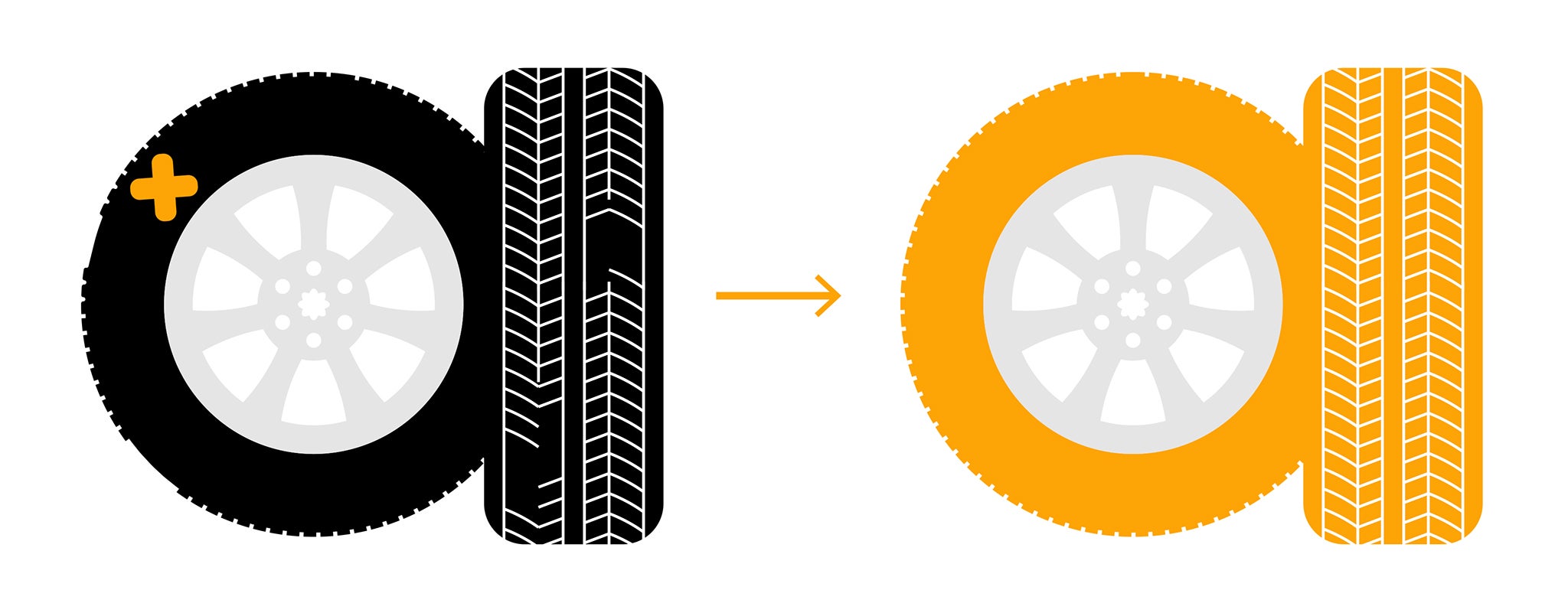
# Tyre Basics
Replacing SUV tyres
There are several indicators that tell you when you should replace your tyres
Most drivers want to avoid replacing tyres as long as possible. However, even with the most advanced tyre technology, it’s important to replace your tyres in order to maintain great performance and maximum safety. And, since they’re the one thing that connects your vehicle to the road, it’s worth investing in quality, durable tyres. While there’s no specific answer as to how often you should replace your SUV tyres, there are several indicators that will tell you when you should replace them. As a general rule, all tyres – including spares – more than ten years old, should be replaced with new ones immediately.
Do you have to replace punctured tyres?
If you own a 4X4 SUV, chances are you take it off-road at least occasionally. As you traverse through mud, snow, rocks or steep inclines in extreme temperatures, the elements can eventually cause damage, especially if you’ve had your tyres for a few years. However, if the puncture occurs on or near the sidewall, you will need to replace the tyre immediately.
If you’re worried about getting caught in the middle of nowhere with a flat tyre, consider getting self supporting runflat tyres or self-repairing ContiSeal™ tyres that allow you to continue driving in the event of a puncture.

Tread depth
Treadwear is a major factor to consider when replacing your tyres. If you have an on-road SUV with tyre tread depth down to 1.6 mm, it’s time to get new tyres.

Please consider that safe driving in wet and snowy weather conditions is affected by the tread depth, the pattern design and the rubber compound of the tread of your tyres. On wet or snow-covered roads braking performance will progressively decline with lower tread depths. On wet roads there is an additional increased risk of aquaplaning with reduced tread depths.
Therefore, check your tyres regularly, reduce your speed on wet and snowy roads and consider replacing your tyres in good time. When your tread depth is low, the chances of getting bogged are high!
In case you're unsure, learn how to check your tread depth here.
Abnormal or uneven tyre wear
If you notice patches of uneven or abnormal wear across your tyre, this may indicate that there is a mechanical problem with your vehicle. Some common issues include improper wheel alignment, a drawback with wheel balance, or an uneven suspension or transmission. Unfortunately, each of these will impact the performance of the tyre, no matter what kind of SUV you have. If you feel you're losing traction while driving and notice uneven wear, have your tyres and your car checked out by a professional.
If it’s not a mechanical problem causing abnormal wear, there’s a good chance that you’re driving with the wrong tyre pressure. If you notice wear on both shoulders of the tyre, it’s most likely underinflated. And if the wear is along the center of the tyre, it’s most likely over-inflated. As a rule of thumb, check your SUV tyre pressure every 2 weeks but at least once a month. No matter if you have summer, winter, all-season, 4X4, or all-terrain tyres, they all need the correct amount of air.
Replace all four tyres at the same time
While it’s possible to switch out only one or two tyres at a time, we strongly recommend replacing all four tyres at the same time for optimal safety and performance. This is especially true for off-road SUVs. Replacing only a single tyre can impact vehicle suspension or transmission and produce excessive wear on the tyre tread. However, if replacing only one tyre, ensure it has the same or similar tread pattern as the other tyre on the same axle. Otherwise, pair the single replacement tyre with the one that has the deepest tread depth, then fit both to the rear axle. Mixing opposite tread patterns will impair the handling characteristics of your car. If you’re unsure of how to replace a single tyre, ask your local tyre dealer, they’ll be happy to help.
To avoid replacing your SUV tyres too often, consider the way you drive. Your driving habits have a direct effect on the life of your tyres. Hard acceleration, sharp and fast turns, and hard braking will only increase wear, so aim to be a mindful driver.
Related content
-
 2023/05/18Off-road tyresIf you're planning on driving off the trail with your car, truck or SUV, you need tires which are appropriate for a whole new set of challenges.Read more
2023/05/18Off-road tyresIf you're planning on driving off the trail with your car, truck or SUV, you need tires which are appropriate for a whole new set of challenges.Read more -
 2024/01/12Replacing SUV tyresThere are several indicators that tell you when you should replace your tires. Even if you've never had a puncture, they could be showing wearRead more
2024/01/12Replacing SUV tyresThere are several indicators that tell you when you should replace your tires. Even if you've never had a puncture, they could be showing wearRead more -
 2024/01/12SUV TyresIf you're looking for new SUV tires, there are several things to consider to ensure safety and quality.Read more
2024/01/12SUV TyresIf you're looking for new SUV tires, there are several things to consider to ensure safety and quality.Read more